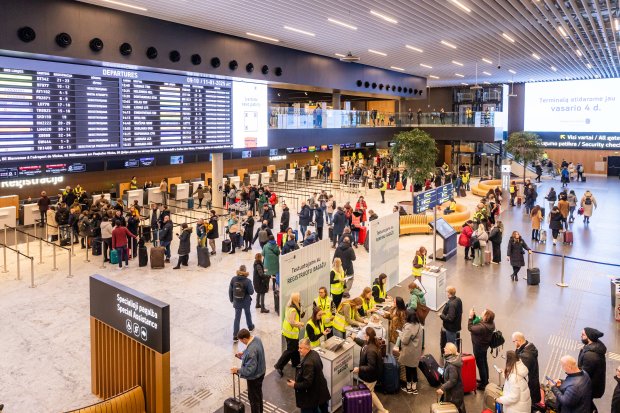Vilnius Airport's New Departures Terminal: Mass Testing Completed with 1,000 Volunteers

On Saturday, January 11, a historic event took place at Vilnius Airport—a mass testing of the new departures terminal. Over 1,000 volunteers registered in record time back in November to participate in this crucial test. Acting as passengers for six simulated flights, the volunteers explored the new terminal and helped Lithuanian Airports teams assess their readiness for the terminal’s grand opening, scheduled for February.
Final Phase
“The terminal will double Vilnius Airport’s passenger capacity, and our goal is to ensure an exceptional passenger experience in parallel. We are deeply grateful to all the testers who dedicated their time to contribute. Their authentic experience and feedback will allow us to evaluate the terminal’s performance under high-demand conditions, address any issues, and implement improvements. This is the first time in airport history we’ve involved the public in such a complex and unique project,” said Simonas Bartkus, CEO of Lithuanian Airports (LTOU).
The testing experience began on the first floor of the new terminal, where volunteers encountered a passenger check-in area with self-service options, including independent baggage drop-off. On the second floor, they navigated through the security screening zone and boarding gates for Schengen-area passengers. Participants were tasked with independently completing typical airport procedures and trying out new systems.
During the test, approximately 140 airport staff members and partners, including aviation security officers, ground handling representatives, and customs officials, simulated real operational processes.
LTOU CEO Simonas Bartkus emphasized that this testing marks the final phase of the new departures terminal project. The collected data will be analyzed through January, alongside a comprehensive review of the terminal’s technological systems, to prepare for the official opening on the morning of February 4, 2025.
A Leap in Technological Advancement
With the new terminal, Vilnius Airport’s passenger capacity is expected to rise from 1,200 to 2,400 passengers per hour. Achieving this milestone has been made possible by technological upgrades, including state-of-the-art equipment enabling more accurate and faster processes for baggage check-in, security screening, and more.
“Our main challenge was integrating various systems to function like a living organism, with artificial intelligence playing a crucial role. The innovations are designed to help passengers and their baggage move through the airport more quickly, safely, and comfortably. During the mass test, we will analyze system performance and interaction. This will also allow staff teams to apply new skills and knowledge in real conditions as they adapt to these technological advancements,” noted Giedrius Paulikaitis, Head of Technology Development at Lithuanian Airports.
One key innovation is the Rapiscan scanner, a 7.5-ton computed tomography-based device for scanning checked baggage. Two such devices form the backbone of the baggage screening system. Using this technology, security specialists can view 3D images of baggage contents, with a four-tier security screening process implemented at Vilnius Airport. Additionally, artificial intelligence is employed to identify various items and substances in passenger luggage.
Valuable Insights
When registration opened in early November, hundreds of volunteers quickly signed up, and the target of 1,000 testers was reached within half a day. Participants were among the first to experience the terminal’s new systems and equipment as passengers.
According to G. Paulikaitis, the testing followed best international practices. It will reveal whether the systems perform as expected when hundreds of people simultaneously check in for several flights. This process is also valuable for airport partners, whose employees will test their readiness, ability to manage new technologies, and capacity to handle various scenarios.
Each participant completed all standard airport procedures, from check-in to boarding, and filled out a questionnaire to evaluate different aspects of terminal operations. As a token of appreciation, testers left the new terminal with unique experiences, impressions, and gifts.


